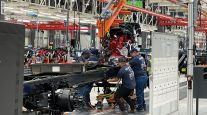Navistar Blames 1Q Loss on Costs for Engine Repairs
This story appears in the March 12 print edition of Transport Topics.
Truck producer Navistar International Corp. reported a loss of $153 million for its fiscal first quarter, attributing $112 million of the loss to costs of repairing faulty engines, including initial models of its 2010 technology engines.
Navistar, Lisle, Ill., also said March 8 that it would use emissions credits that would allow it to continue selling engines through this year in California and nine other states that follow California’s emissions plan, but it would pay penalties to sell engines in 40 other states.
Daniel Ustian, Navistar chairman and CEO, said Navistar is including $25 million in its financial projections to pay the EPA nonconformance penalties.
“That should take us through the year to try and quiet the noise of the uncertainty that some have had out there about whether we can ship products,” Ustian said. “So we feel this is the best answer for us for this year, and we’ve included for the year $25 million of cost in our guidance.”
Navistar had $3.05 billion in revenue in its fiscal-year first quarter that ended Jan. 31, compared with $2.74 billion in the same period last year when it lost $6 million.
The company lowered its guidance for the entire fiscal year to between $365 million and $295 million in profits, down from $350 million to $400 million. Ustian said the company will make up much of its first-quarter losses in the second half of its fiscal year.
Navistar said 45% of its warranty costs were for engines built from 2006 to 2008, 45% from the “early launch 2010” models and 10% from engines in Brazil. The company did not disclose the number of engines in each group.
Navistar said it decided to do much of the warranty repairs in December, which it said usually was a slow period for its factories and for fleets, resulting in such a large charge for the quarter. The company said warranty costs for the latter half of its fiscal year could be between $50 million and $60 million.
Asked by an analyst what engine components were faulty, Ustian said that the entire engine had to be considered one unit.
“When you get into these things, everything is so electronically controlled that, when you do a calibration on it, it could affect whether the performance of any part of
that engine works or not,” Ustian replied. “And when you have . . . so many different variations that the electronic controls have to be able to adapt to each one of those. . . it’s more of a system thing, I think, than that it is a part thing.”
Ustian said that the problem applied only to initial 2010 models and said the units now being built have been getting good reviews from customers.
Navistar’s truck division lost $41 million in the quarter, compared with $32 million in profits last year. Its engine division lost $120 million, compared with a $6 million loss last year.
The parts division brought in $50 million in income, compared with $56 million in profits in the first quarter last year.
Navistar said that additional reasons for its losses included higher year-over-year health-care costs; the start-up of a new foundry operation; the Bendix brake-part issue that interrupted truck shipments; and the temporary shutdown of a key truck manufacturing customer of its South America after floods cut off needed components from Thailand.
Outlining the strategy that will allow it to continue selling trucks in all 50 states, although its heavy-duty engines do not comply with the Environmental Protection Agency’s 2010 nitrogen oxides emission standard, Ustian said the truck maker plans to pay EPA penalties of up to $1,900 for each 2010 noncompliant heavy-duty engine it sells in 40 states.
In California and nine other states that have adopted California’s emissions certification model, the company said it will use EPA emissions credits it earned in past years when some of its engines burned more cleanly than federal standards required.
The company has not yet disclosed when it expects the emissions credits to run out.
In late January, the truck maker formally submitted to the EPA a 13-liter heavy-duty engine that it said meets the current 0.2 gram per brake horsepower-hour NOx emission standard. Ustian said the certification process typically takes three months.
“So when we get the certification, it will still take some time for us to get to production on that,” Ustian said. “So what we’re doing right now is getting ready to go to production in that, and it will be about June before we can get into production with that particular engine.”
Navistar said that it will submit its 11-liter and 15-liter models to EPA for certification after it receives the 13-liter certification.
Navistar spokesman Steve Schrier told Transport Topics that Navistar is continuing to manufacture all three engines.




